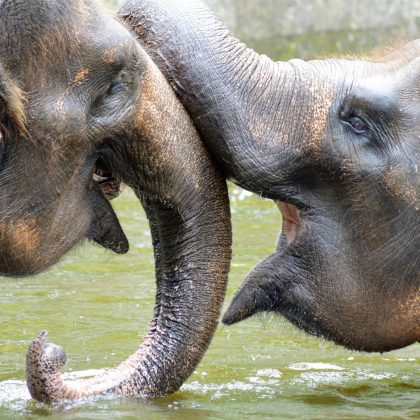First country-wide distribution survey of the Endangered Asian elephant: towards better elephant conservation and management in Sri Lanka
Asian elephants are a paradox in many ways. They are an Endangered species whose global population is less than one tenth of that of African elephants. Yet they come into serious conflict with people, precipitating management actions that threaten their survival. Although wild Asian elephants benefit from a high level of legal protection, one third of the global population is in captivity, with most of them being wild-caught. People have had complex and close relationships with Asian elephants for thousands of years, yet we know comparatively little about the ecology and behaviour of these fascinating creatures in the wild. Even their distribution has been a matter of guesswork and conjecture.
In a study published in Oryx—The International Journal of Conservation, we present the first survey-based distribution map of the Asian elephant for an entire country within its range. We conducted surveys across Sri Lanka based on a 5 × 5 km grid, interviewing three residents per grid cell. The interviews provided information about elephants in 2,214 grid cells, which covered 81% of Sri Lanka. In another 500 grid cells that were mostly protected areas, there were no residents to be interviewed and elephant presence was determined based on adjacent cells.

We found that elephants currently occur across 60% of Sri Lanka, which is a much greater area than previously thought, based on expert opinion. All protected areas within elephant range were deemed to have elephants, but 70% of the country’s elephant range lay outside the protected areas. This is despite the fact that for more than 50 years the government has attempted to confine elephants to protected areas, to manage human–elephant conflict.

The findings show that people and elephants cannot be separated by limiting elephants to protected areas, as it requires eliminating elephants from 70% of their current range, and confining all elephants in only 30% of their range. Suitable elephant habitats, particularly the protected areas in Sri Lanka, are probably already at their carrying capacity. Driving elephants into protected areas and confining them there with electric fences leads to elephants starving to death, which has been observed previously in a number of Sri Lankan protected areas. Because elephants are not territorial, such management affects not only elephants that are driven into protected areas, but also those already resident inside. Thus we conclude that the only viable option for elephant conservation and human–elephant conflict mitigation is a human–elephant coexistence model with management of elephants where they are.

The global range of the Asian elephant has declined severely in recent decades and is heavily fragmented, leading to isolated populations that are unable to interact with each other. Our study found that areas inhabited by elephant groups in Sri Lanka were largely contiguous, except for two small groups that were isolated in the wet zone of the country. Therefore, Sri Lankan elephants can be considered to represent a single population. However, only adult males occupied some areas that previously also held herds with females and young. Males tolerate higher levels of interaction with people and therefore continue to occupy areas that have become partly developed. Continued development, and consequent elimination of all elephants in these areas, will result in the fragmentation of the current single Sri Lankan population into a number of subpopulations. Such fragmentation is detrimental to the elephants’ survival. The results of the survey help identify areas where conservation measures are urgently needed to prevent such loss of connectivity.
We were also able to glean information on the past presence of elephants in areas where they were now absent and vice versa: Elephants lost around 16% of their range in the past 55 years and expanded their range by 1.5%. Because population size is directly related to the area occupied, this range loss indicates a declining population, contrary to the popular belief that the number of elephants in Sri Lanka is increasing.

Elephants were absent from 40% of Sri Lanka, specifically from densely populated urban areas. However, 70% of the country’s elephant range consisted of semi-developed areas with heterogeneous habitats, comprised of natural vegetation interspersed with agricultural land and human dwellings. Thus, the majority of elephants in Sri Lanka occupied highly fragmented and disturbed habitats. The fact that elephants can survive in such landscapes is responsible for the persistence of over 10% of the global Asian elephants population in Sri Lanka, in less than 2% of their global range. It also highlights the importance of disturbed and degraded habitats in Asian elephant conservation.
The study illustrates the fallacy of many beliefs on which elephant management has been based and underscores the importance of evidence-based decision making for effective elephant conservation and mitigation of conflict between people and elephants.
Photo credit: Centre for Conservation and Research, Sri Lanka (ccrsl.org)
The Open Access article ‘First country-wide distribution survey of the Endangered Asian elephant: towards better elephant conservation and management in Sri Lanka’ is available in Oryx—The International Journal of Conservation.







Priceless work for elephant conservation in Sri Lanka. Well done.
Some valuable conclusions based on years of good scientific research. Policy has been formulated based on these findings, but the will to make these into law and implement those regulations is still resisted.